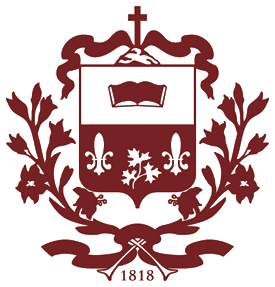
The Université de Saint-Boniface (USB) is a French-language public university located in the Saint Boniface neighbourhood of Winnipeg, Manitoba, Canada. An affiliated institution of the University of Manitoba, the university offers general and specialized university degree programs as well as technical and professional training. In 2014, 1,368 regular students were enrolled. Its Continuing Education Division, which includes a language school, has also counted over 4,200 enrolments.

Franco-Manitobans are French Canadians or Canadian francophones living in the province of Manitoba. According to the 2016 Canadian Census, 40,975 residents of the province stated that French was their mother tongue. In the same census, 148,810 Manitobans claimed to have either full or partial French ancestry. There are several Franco-Manitoban communities throughout Manitoba, although the majority are based in either the Winnipeg Capital Region or the Eastman Region.
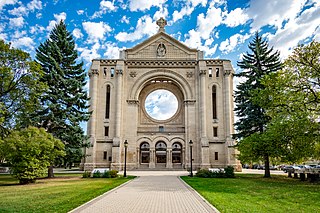
Saint Boniface Cathedral is a Roman Catholic cathedral of Saint Boniface, Winnipeg, Manitoba, Canada. It is an important building in Winnipeg, and is the principal church in the Roman Catholic Archdiocese of Saint Boniface, serving the eastern part of Manitoba province as well as the local Franco-Manitoban community. The church sits in the centre of the city at 190 avenue de la Cathédrale, Saint Boniface. Before the fire on July 22, 1968, which destroyed the previous building on site, the church was a minor basilica.
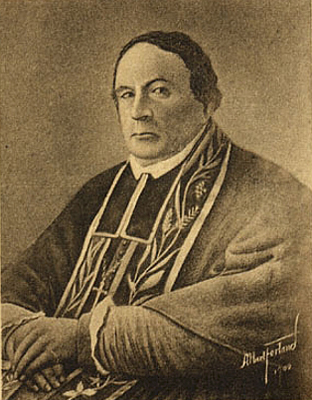
Joseph-Norbert Provencher was a Canadian clergyman and missionary and one of the founders of the modern province of Manitoba. He was the first Bishop of Saint Boniface and was an important figure in the history of the Franco-Manitoban community.
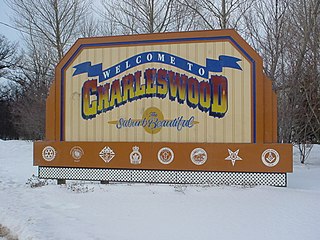
Charleswood is a residential community and neighbourhood in Winnipeg, Manitoba, Canada. It is located in the South-West of the city and is bordered by the neighbourhoods Tuxedo to the East, Fort Whyte to the South, and the Rural Municipality of Headingley on the West. It's boundaries are Roblin and the Assiniboine River to the north, Shaftesbury Boulevard on the East, Wilkes Avenue to the South and the Perimeter Highway to the West.

Southdale is a provincial electoral division in the Canadian province of Manitoba. It was created in the provincial redistribution 1999, mostly out of Niakwa and part of St. Vital. The riding is located in the southeastern section of the City of Winnipeg.
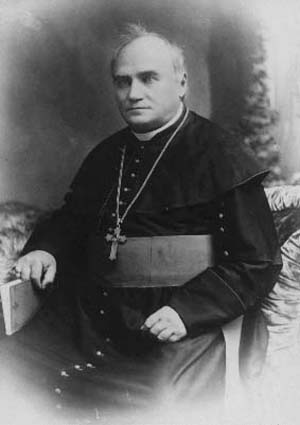
Alexandre-Antonin Taché, O.M.I., was a Canadian Roman Catholic priest, missionary of the Oblate order, author, and the first Archbishop of Saint Boniface in Manitoba, Canada.

The Festival du Voyageur is an annual 10-day winter festival that takes place in Winnipeg, Manitoba, Canada. The event is held each February in Winnipeg's French quarter, Saint-Boniface, and is western Canada's largest winter festival. It celebrates Canada's fur-trading past and unique French heritage and culture through entertainment, arts and crafts, music, exhibits, and displays.
St. Vital is a ward and neighbourhood of Winnipeg, Manitoba, Canada.

St. James-Assiniboia is a major community area in Winnipeg, Manitoba, Canada. As it encapsulates most of the city ward of St. James, which includes the major St. James Street, the area itself is often simply referred to "St. James."
Taché Avenue is a street in the neighbourhood of St. Boniface in Winnipeg, Manitoba, Canada. The road forms a portion of the city's primary diking system to defend against flooding along the Red River.

St. Norbert is a bilingual neighbourhood and the southernmost suburb of Winnipeg, Manitoba, Canada. While outside the Perimeter Highway, it is still part of the city. As of the 2016 Census, the population of St. Norbert is 5,850.
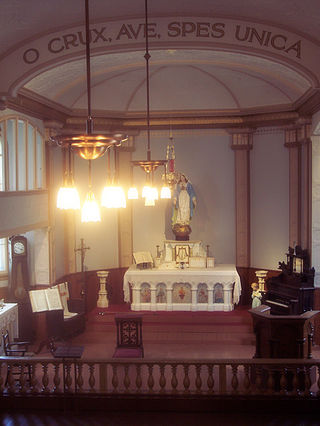
Le Musée de Saint-Boniface Museum is a museum in Winnipeg, Manitoba, Canada, that is dedicated to Franco-Manitoban and Métis culture and history.
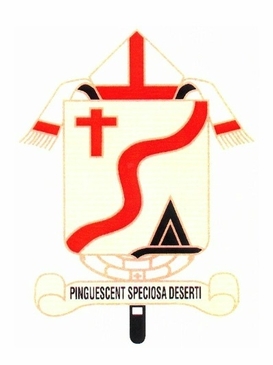
The Roman Catholic Archdiocese of Saint-Boniface is a Latin archdiocese in part of the civil Province of Manitoba in Canada. Despite having no suffragan dioceses, the archdiocese is nominally metropolitan and is an ecclesiastical province by itself. It is currently led by Archbishop Albert LeGatt.

St. Adolphe, or Saint Adolphe, originally called Pointe-Coupée, is a community in the Rural Municipality of Ritchot, Manitoba, Canada. It is located along the east bank of the Red River, approximately 12 kilometres south of Winnipeg.
The 2002 Winnipeg municipal election was held on 23 October 2002 to elect a mayor, councillors and school trustees in the city of Winnipeg.
Miguel Joyal is a Canadian-born artist and sculptor.

Riel House is a National Historic Site commemorating the life of the Métis politician and activist Louis Riel, and also the daily life of Métis families in the Red River Settlement. The house is situated in the historic St. Vital parish of Winnipeg, in Manitoba, Canada. From 1865, the residence belonged to Riel's mother, Julie Riel (Lagimodière), and housed his brothers and their families. Louis Riel lived along with them from his return to Red River in 1868, through the Red River Resistance, until his exile in 1870. It is also where his body lay in state for two days in December 1885, after his sentencing and execution for murder and treason, before being buried in St. Boniface. The house remained within the possession of Riel descendants until 1968, when it was acquired by the Winnipeg Historical Society.
École Provencher is the oldest school in Saint Boniface, Winnipeg, Manitoba.





















